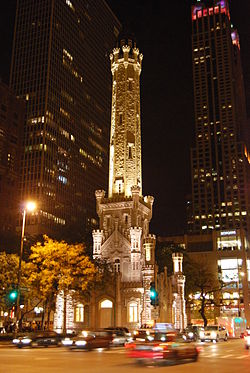Chicago Water Tower
Chicago Avenue Water Tower and Pumping Station | |
 The Chicago Water Tower | |
| Location | 806 N Michigan Avenue, Chicago, Illinois |
|---|---|
| Built | 1869 |
| NRHP reference No. | 75000644 [1] |
| Added to NRHP | April 23, 1975 |
The Chicago Water Tower is a contributing property in the Old Chicago Water Tower District landmark district. It is located at 806 North Michigan Avenue along the Magnificent Mile shopping district in the Near North Side community area of Chicago, Illinois. The tower was constructed to house a large water pump, intended to draw water from the Lake Michigan; it now serves as a Chicago Office of Tourism art gallery. The Chicago Water Tower is the second-oldest water tower in the United States, after the Louisville Water Tower in Louisville, Kentucky.
History

The tower, built in 1869 by architect William W. Boyington from yellowing Joliet limestone,[2] is 154 feet (47 m) tall. Inside was a 138 foot (42 m) high standpipe to hold water. In addition to being used for firefighting, the pressure in the pipe could be regulated to control water surges in the area.[3] Together with the adjacent Chicago Avenue Pumping Station, it drew clean water from water cribs in Lake Michigan.
The tower gained prominence after the Great Chicago Fire of 1871. While some incorrectly believe that the tower was the only building to survive the fire, a few other buildings in the burned district survived along with the tower.[4][5] The tower was the only public building in the burned zone to survive, and is one of just a few of the surviving structures still standing. In the years since the fire, the tower has become a symbol of old Chicago and of the city's recovery from the fire. In 1918, when Pine Street was widened, the plans were altered in order to give the Water Tower a featured location.[3]
The tower has undergone two renovations. The first took place during a three-year period, 1913–1916. At that time many of the limestone blocks were replaced. The second renovation occurred in 1978. This renovation consisted mostly of interior changes with only minor changes made to the exterior of the building.[6]
The structure has not been universally admired. Oscar Wilde said it looked like "a castellated monstrosity with pepper boxes stuck all over it," although he did admire the arrangement and movement of the pumping machinery inside.[7] The Water Tower's castle-like style inspired the design of many White Castle restaurant buildings.[8] The Tower was named an American Water Landmark in 1969. In 2004, the tower was featured in the finale of The Amazing Race 6.
References

- ^ "National Register Information System". National Register of Historic Places. National Park Service. March 15, 2006.
- ^ http://www.wttw.com/main.taf?p=32,2,1,16
- ^ a b Gerald Wolfe. Chicago In and Around the Loop. McGraw-Hill, 1996. pp.233-236
- ^ A.T. Andreas (1885), History of Chicago, Vol. 2, pp. 752 (picture of E.B. McCagg's Greenhouse), 759 (discussing survival of the Lind Block and 2 houses), Chicago: A.T. Andreas Co.
- ^ Cf. The Couch Tomb. Bannos, Pamela (2012). "The Couch Tomb — Hidden truths: Visualizing the City Cemetery". The Chicago Cemetery & Lincoln Park. Northwestern University. Retrieved November 15, 2012.
- ^ The Historic Water Tower: Chicago's Gem, http://www.illinoishistory.gov/Illinois%20History/Feb0424.pdf
- ^ Siegel, Arthur. Chicago's Famous Buildings. University of Chicago Press, 1969. pp. 48.; Oscar Wilde. February 13, 1882
- ^ Gardner, Denis P. (2004). Minnesota Treasures: Stories Behind the State's Historic Places. St. Paul, Minnesota: Minnesota Historical Society. ISBN 0-87351-471-8.
{{cite book}}: Cite has empty unknown parameter:|coauthors=(help)
See also
- Buildings and structures in Chicago, Illinois
- Landmarks in Chicago, Illinois
- National Register of Historic Places in Chicago, Illinois
- Water towers in the United States
- Towers completed in 1869
- Water supply infrastructure on the National Register of Historic Places
- Towers in Illinois
- Government buildings on the National Register of Historic Places in Chicago, Illinois
- Historic district contributing properties in Illinois

